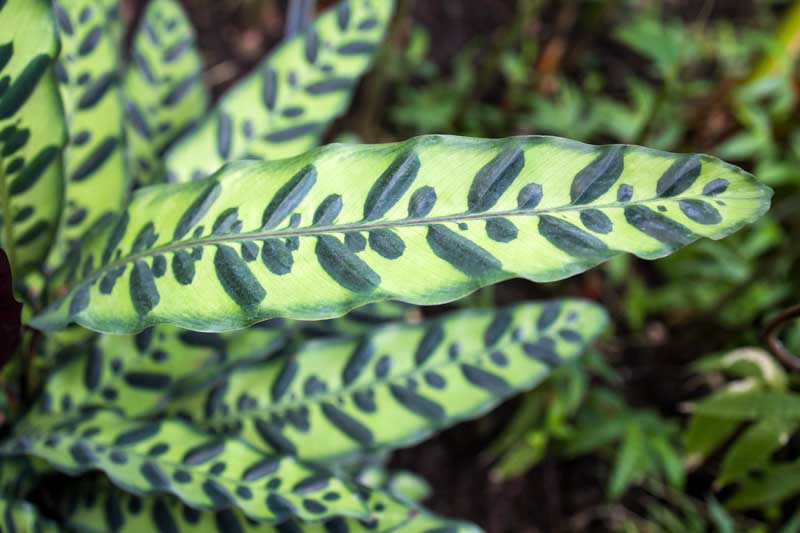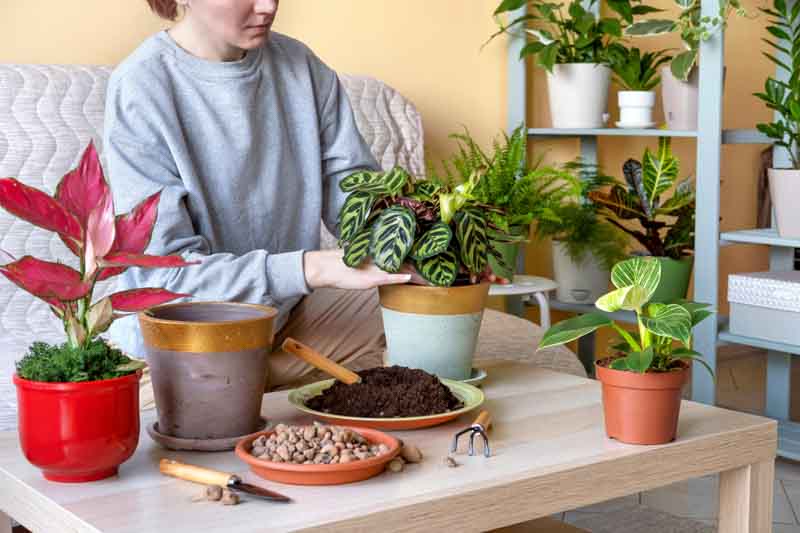Rattlesnake Plant, Goeppertia lancifolia, Calathea insignis, Goeppertia insignis
Calathea lancifolia, commonly known as the Rattlesnake Plant, is a fascinating and ornamental houseplant that has captured the hearts of indoor gardening enthusiasts with its unique appearance and intriguing characteristics. This species, formerly assigned to Calathea, is now in the genus Goeppertia.
The Rattlesnake Plant is distinguished by its slender, wavy-edged leaves, which bear a striking resemblance to a rattlesnake’s skin, hence its common name. The top side of each leaf features a pattern of dark green ovals on a lighter green background, while the underside is a vibrant purple, adding to its visual appeal.
Native: This species is native to the Brazilian rainforests, where it thrives under the canopy in warm, moist, and shaded conditions, indicating its preference for similar environments when grown indoors. It belongs to the arrowroot family (Marantaceae), along with the Prayer Plant.
Plant Type and Habit: The Rattlesnake Plant is a clump-forming evergreen perennial which grows upright and spreads outwards, creating a lush, full appearance with its foliage.
Size: The Rattlesnake Plant typically reaches a height of 2 feet (60 cm) and a similar spread, making it an ideal size for indoor cultivation in pots or containers.
Flowers: Although it is primarily grown for its foliage, the Rattlesnake Plant can produce small, inconspicuous, yellow flowers during the growing season. However, these blooms are rarely seen when the plant is kept indoors.
Foliage: The foliage is the most notable feature of the Rattlesnake Plant, with each leaf displaying a unique pattern that adds to the plant’s ornamental value. It showcases undulate, lance-shaped pale green leaves adorned with dark patches alongside the midrib, contrasting with its deep purple underside. This striking foliage, resembling a rattlesnake’s skin, makes it a captivating addition to any indoor plant collection.
Hardiness: The Rattlesnake Plant is hardy in USDA zones 11-12. It is not frost-tolerant and must be kept in environments above 60°F (15°C) to thrive.
Uses: Primarily used for decorative purposes, the Rattlesnake Plant enhances interior spaces with its lush, vibrant foliage.
Toxicity: Calathea plants are non-toxic to cats, dogs, and humans, making them a safe choice for pet owners and families. Their sap may irritate sensitive skin.
Benefits: Beyond its ornamental appeal, it improves indoor air quality by filtering out pollutants.

Caring for a Rattlesnake Plant involves creating a balanced environment that mimics its native tropical habitat.
Light: Prefers bright, indirect sunlight. Direct sun can fade the stripes on the leaves and cause burn marks. Ideal near a window with sheer curtains or in a room that receives plenty of natural light without direct exposure.
Soil: A well-draining, peat-based mix is suitable. Mix in perlite or vermiculite to enhance drainage.
Water: Keep the soil consistently moist but not waterlogged. Overwatering can lead to root rot. Use distilled, rainwater, or filtered tap water to avoid leaf browning from fluoride and other chemicals in tap water.
Temperature and Humidity: Thrives in temperatures between 65°F (18°C) to 75°F (24°C). Avoid sudden temperature drops and cold drafts. Requires high humidity levels, ideally above 60%. Low humidity can lead to brown leaf tips and edges. Use a humidifier, place the plant on a pebble tray filled with water, or group it with other plants to increase surrounding humidity.
Fertilization: Feed with a diluted, balanced, liquid houseplant fertilizer every 4 weeks during the growing season (spring and summer). Do not fertilize in winter.
Pruning: Trim away yellow or brown leaves at the base to keep the plant looking tidy and to encourage new growth.
Cleaning: Wipe leaves with a damp cloth to remove dust and help the plant breathe.
Repotting: Every 2-3 years or when the plant becomes root-bound. Use a slightly larger pot and fresh potting mix to encourage growth.
Propagating a Calathea plant, like many other members of the Calathea genus, is best done through division. This method ensures the new plants have a good start with established roots and foliage.
Choose the Right Time: The best time for propagation is in late spring when the plant is in its active growth phase.
Prepare Your Tools and Workspace: Ensure you have clean, sharp scissors or a knife, pots for the new plants, and appropriate potting mix (peat-based or similar to what the parent plant is in). Sterilize your tools with rubbing alcohol or a bleach solution to prevent the spread of disease.
Remove the Plant from Its Pot: Carefully take your Calathea plant out of its pot. You may need to tap the pot’s sides or gently pull the plant by the base to ease it out.
Inspect and Separate the Rhizomes: Look for natural divisions in the root ball where the plant has formed distinct clumps or sections. These are your propagation points. Gently tease the roots apart with your fingers or cut through them with your clean, sharp tool if necessary. Ensure each division has a good amount of roots and at least one or two shoots (leaves).
Pot Up the Divisions: Fill your new pots with a suitable potting mix, making a hole in the center for the division. Place each division in its pot, ensuring it sits at the same depth as in the original pot. Fill around the roots with more potting mix, gently firming to support the plant.
Water and Care for Your New Plants: Water each new Calathea plant thoroughly after potting to settle the soil around the roots and eliminate air pockets. Keep the soil consistently moist but not waterlogged. Place the new plants in a warm, humid spot with indirect light, similar to the parent plant’s preferred conditions.
Monitor and Maintain Humidity: To ensure high humidity, you can cover the pots with plastic bags to create a greenhouse effect. Ensure to open the bag daily for fresh air and check the soil moisture.
Be Patient: Growth may be slow initially as your Calathea plant adjusts and develops new roots and foliage. It can take several weeks to see significant growth.

The Rattlesnake Plant is relatively resistant to major problems, but like all indoor plants, it can encounter some pests, diseases, and common issues.
Spider Mites: These tiny pests can be identified by the fine webs they weave on the plant. They cause yellowing or speckled leaves. Increase humidity around the plant and wash it with a strong stream of water. For severe infestations, use insecticidal soap or neem oil.
Mealybugs: These white, cottony pests tend to cluster in leaf axils and under leaves, sucking sap and weakening the plant. Remove with alcohol-dipped cotton swabs or apply neem oil.
Aphids: Small, soft-bodied insects that can be green, black, brown, or pink, aphids typically feed in groups on the undersides of leaves. Combat them with a gentle spray of water, neem oil, or insecticidal soap to protect the plant’s health and appearance.
Scale insects: Hard or soft-bodied insects that attach themselves to the stems or leaves, causing yellowing and growth stunting. Scrape off with a fingernail or use a cotton swab dipped in rubbing alcohol. Insecticidal soap or neem oil may also be used.
Root rot: Often a result of overwatering, leading to brown, mushy roots and wilted leaves. Prevent by ensuring good drainage and letting the soil partially dry between waterings. Affected plants may need repotting with fresh soil after cutting away any rotten roots.
Leaf spot: Fungal or bacterial infections causing spots on leaves. Avoid wetting foliage when watering and improve air circulation. Remove affected leaves and treat with fungicides if necessary.
Brown Leaf Edges/Tips: Often a result of low humidity or fluoride in tap water. Use distilled water or rainwater and increase humidity around the plant.
Curling Leaves: Can indicate under-watering or too low humidity. Ensure consistent soil moisture and raise humidity levels.
Fading Leaf Color: Insufficient light can cause the vibrant patterns of your Calathea to fade. Provide bright, indirect light, but avoid direct sunlight, which can scorch the leaves.
While not the easiest plants to care for, Rattlesnake plants can thrive with the right conditions. They require consistent moisture, high humidity, and protection from direct sunlight. Understanding and meeting their specific needs regarding light, water, and humidity is key.
Rattlesnake plants prefer bright, indirect sunlight. Direct sun can scorch their leaves, while too little light can cause them to lose their vibrant markings. A spot near a window with sheer curtains is often ideal, providing ample light without direct exposure.
Yes, Rattlesnake plants enjoy high humidity and benefit from regular misting, which helps mimic their native tropical environment. Misting can also help keep their leaves clean and free from dust, allowing them to breathe better.
Place your Rattlesnake plant in a location that receives bright, indirect light and where the humidity is relatively high. This can include bathrooms with natural light, kitchens, or other well-lit areas of your home. Avoid placing it near heating vents, air conditioners, or drafts, as they prefer stable temperatures and high humidity.
| Hardiness |
11 - 12 |
|---|---|
| Plant Type | Houseplants, Perennials |
| Plant Family | Marantaceae |
| Genus | Calathea, Goeppertia |
| Exposure | Partial Sun |
| Season of Interest |
Spring (Early, Mid, Late) Summer (Early, Mid, Late) Fall Winter |
| Height |
1' - 2' (30cm - 60cm) |
| Spread |
1' - 2' (30cm - 60cm) |
| Maintenance | Low |
| Water Needs | Average |
| Soil Type | Loam, Chalk, Clay |
| Soil pH | Acid, Neutral, Alkaline |
| Soil Drainage | Moist but Well-Drained, Well-Drained |
| Characteristics | Showy, Evergreen |
| Garden Uses | Patio And Containers |
| Hardiness |
11 - 12 |
|---|---|
| Plant Type | Houseplants, Perennials |
| Plant Family | Marantaceae |
| Genus | Calathea, Goeppertia |
| Exposure | Partial Sun |
| Season of Interest |
Spring (Early, Mid, Late) Summer (Early, Mid, Late) Fall Winter |
| Height |
1' - 2' (30cm - 60cm) |
| Spread |
1' - 2' (30cm - 60cm) |
| Maintenance | Low |
| Water Needs | Average |
| Soil Type | Loam, Chalk, Clay |
| Soil pH | Acid, Neutral, Alkaline |
| Soil Drainage | Moist but Well-Drained, Well-Drained |
| Characteristics | Showy, Evergreen |
| Garden Uses | Patio And Containers |
How many Calathea lancifolia (Rattlesnake Plant) do I need for my garden?
| Plant | Quantity | |
|---|---|---|
| Calathea lancifolia (Rattlesnake Plant) | N/A | Buy Plants |
Create a membership account to save your garden designs and to view them on any device.
Becoming a contributing member of Gardenia is easy and can be done in just a few minutes. If you provide us with your name, email address and the payment of a modest $25 annual membership fee, you will become a full member, enabling you to design and save up to 25 of your garden design ideas.
Join now and start creating your dream garden!
Create a membership account to save your garden designs and to view them on any device.
Becoming a contributing member of Gardenia is easy and can be done in just a few minutes. If you provide us with your name, email address and the payment of a modest $25 annual membership fee, you will become a full member, enabling you to design and save up to 25 of your garden design ideas.
Join now and start creating your dream garden!